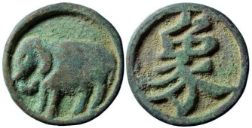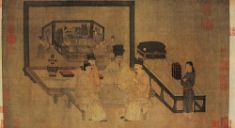A game on the move
Being made of ivory (a material somewhat fittingly made from elephant tusks), our chess piece must have belonged to quite an expensive set, in spite of what its current craggy and uneven surface might suggest.
In fact, size, imagery and material adapted as the game travelled and changed. Sometimes chess sets took the shape of the intricately carved statuettes of ancient India; other times they morphed into the more stylized stone pieces of the Islamicate lands. The biggest change can be seen when chess arrived into China, becoming the game of xiangqi. Pieces no longer appeared as figurative statuettes, but as smooth disks, distinguished from one another by characters inscribed on their surface.
Similarities in gameplay between the Chinese chaturanga-xiangqi adaptation and a first-century ancient Chinese board game also named xiangqi suggest that the imported game was absorbed into a pre-existing framework, perhaps explaining why the smooth disks of Chinese chess more closely resemble the game pieces from ancient Chinese sets than carved statuettes.
While chess in India and Persia was considered an elite, courtly pastime, xiangqi seems to have never reached the cultural esteem that weiqi (also known by its Japanese name, go) held among Chinese literati.
Perhaps this disparity in status is connected to the way in which the game was introduced into the different cultural landscapes. While it moved across southern Asia mainly through conquest and diplomatic channels, chess is thought to have arrived in China through the prospering Islamic community of merchants and administrators, which existed at least since the seventh century and acted as a cultural and material bridge between eastern and western regions of Asia.
](https://micrio.thingsthattalk.net/WmPAu/views/max/128x128.png)
](https://micrio.thingsthattalk.net/qeLtm/views/max/174x128.png)
](https://micrio.thingsthattalk.net/GdYOR/views/max/173x128.jpg)

